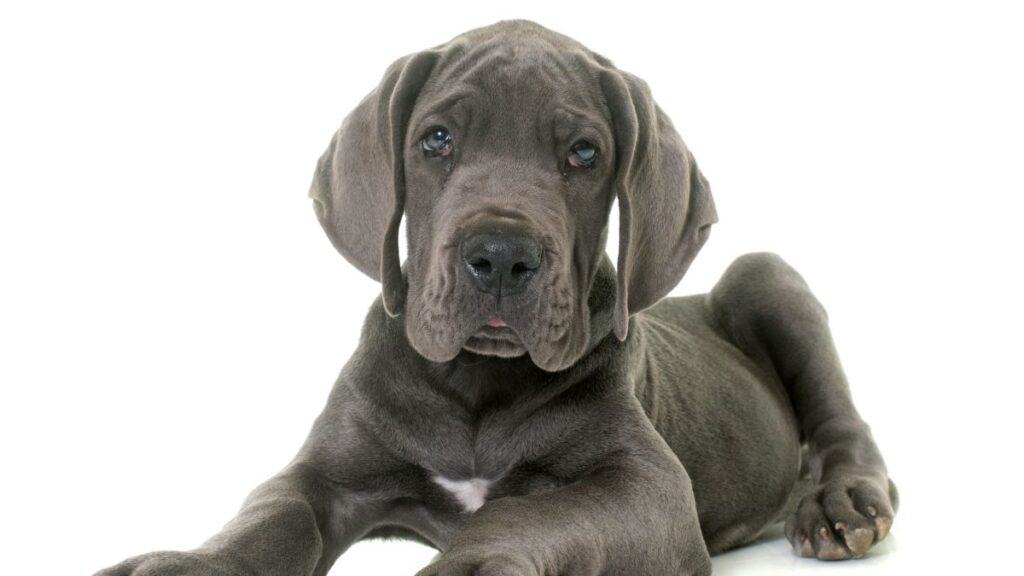
Dive into the world of the Blue Great Dane, a beautful hue that captivates with its unique coat color. This article explores the charm and characteristics of these striking canines, perfect for enthusiasts and potential owners alike!
Table of Contents
Understanding the Breed Standard
The Blue Great Dane is a unique and rare dog breed known for its striking steel blue coat and gentle giant personality.
This breed owes its enchanting appearance to the recessive blue gene, which gives them a pale bluish color that sets them apart from the average Great Dane.
The Blue Great Dane can also be found in several color variations, including blue merle, blue harlequin, and blue fawn. These color variations are the result of the dilution gene, which affects the color of their coat.
This color is achieved through careful breeding and is highly sought after by breeders and owners alike.
Tip: To learn more about the official Great Dane colors, take a look at my dedicated article!
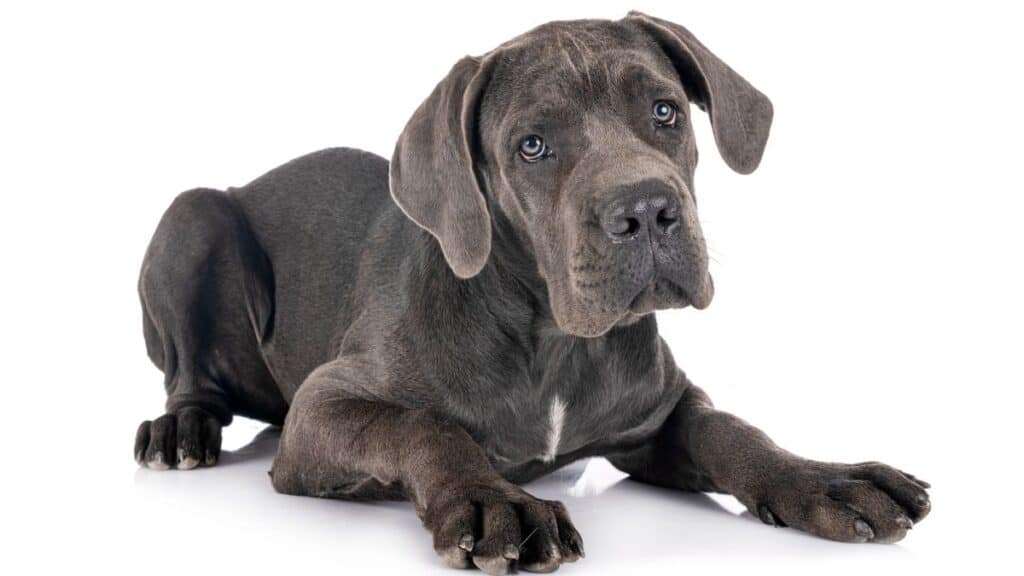
Physical Characteristics
Blue Great Danes are a striking breed of dog known for their tall and elegant stature. They are one of the largest dog breeds and are often referred to as “gentle giants.”
Males can stand between 30 to 32 inches at the shoulder, while females measure 28 to 30 inches. They weigh between 110 to 180 pounds, making them a substantial presence in any home.
The coat of a Blue Great Dane is a pure steel blue color, which can range from light to dark shades. They can also come in other shades of blue, such as charcoal blue, slate, and pale bluish color.
Some Blue Great Danes can be born with blue eyes, but this is not always the case.
According to the AKC standard for Blue Great Danes, white markings at the chest and toes are not desirable. Any variance in color or markings as described above shall be faulted to the extent of the deviation.
The color shall be a pure steel blue. White markings on the chest and toes are not desirable.
AKC breed standard for blue Great Danes
Any Great Dane that does not fall within the above color classifications must be disqualified.
Some Blue Great Danes have a mantle or harlequin pattern, which is a combination of white and black. However, it is important to note that no white markings are allowed on a Blue Great Dane with no mantle or harlequin pattern.
The steely blue coat of a Blue Great Dane is one of their most recognizable features. It is a smooth and glossy coat that is easy to maintain.
However, despite their short coat, they can still shed quite a bit, so regular grooming is necessary to keep their coat healthy and shiny.
In terms of eye color, Blue Great Danes typically have brown eyes, but some can have blue or parti-colored eyes. Parti-colored eyes are when one eye is a different color than the other.
Blue Great Danes are a beautiful and unique breed with many physical characteristics that make them stand out. From their striking coat to their towering stature, these dogs are sure to turn heads wherever they go.
Blue Great Dane Temperament
Blue Great Danes are known for their gentle giant nature and are often referred to as companions due to their friendly and affectionate personalities. They are sweet, intelligent, and lovable dogs that make excellent family pets!
These gentle giants are known to be good with children, and their affectionate nature makes them a perfect addition to any family. They are highly intelligent and respond well to training, making them easy to train and excellent guard dogs.
Blue Great Danes are alert and always on the lookout for any potential danger, making them excellent watchdogs. They are loyal to their owners and will do anything to protect them.
Although they are large dogs, they are gentle and loving, which makes them great for families with children. They are not aggressive and are known to be very patient with children.
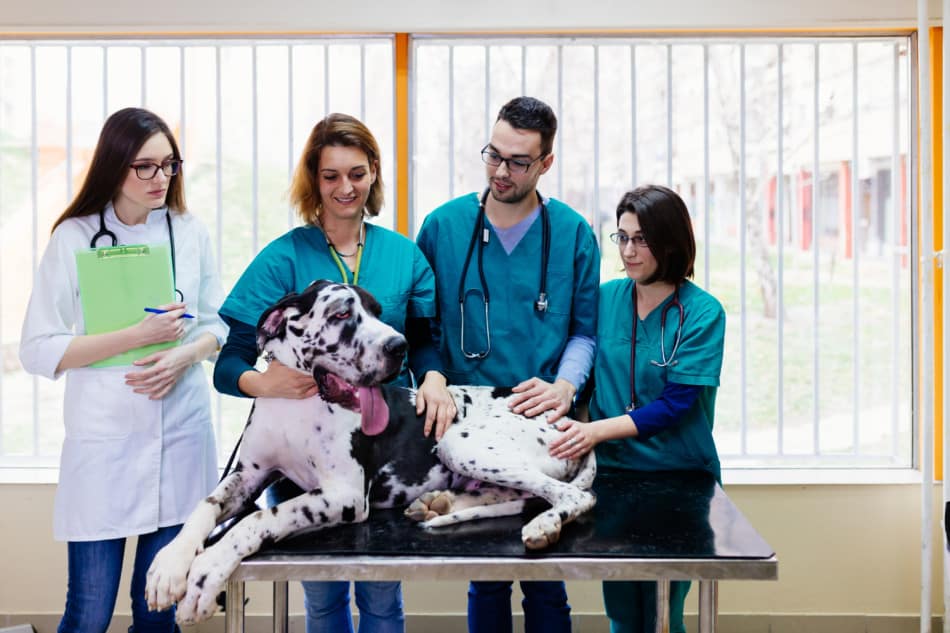
Health Considerations
Blue Great Danes are generally healthy dogs, but like all breeds, they are prone to certain health issues.
Responsible breeders will screen their dogs for genetic health problems and provide health clearances for potential buyers.
Lifespan and Weight
In general, Great Danes have an average lifespan of 7-10 years.
Blue Great Danes have similar lifespans that fall within the breed average, but it is important to note that as a breed, they are prone to certain health issues that may shorten their lifespan.
Health Problems
Blue Great Danes are prone to certain health problems, including hip dysplasia, dilated cardiomyopathy, tricuspid valve disease, and gastric torsion (bloat).
- Hip dysplasia is a genetic condition that affects the hip joint, causing pain and discomfort.
- Dilated cardiomyopathy is a heart disease that causes the heart to enlarge, making it difficult for it to pump blood effectively.
- Tricuspid valve disease is a condition that affects the heart valve, causing it to leak blood.
- Gastric torsion, also known as bloat, is a life-threatening condition that occurs when the stomach fills with gas and twists on itself.
Color Dilution Alopecia and HOD
Blue Great Danes may also be prone to color dilution alopecia, a condition that affects their coat and can cause hair loss and skin irritation.
They may also be prone to hypertrophic osteodystrophy (HOD), a bone disease that affects young dogs and causes pain and swelling in the limbs.
Mutation
The blue color in Blue Great Danes is caused by a mutation in the dilution gene. While this mutation is responsible for the unique color, it can also lead to health problems such as color dilution alopecia.
In summary, Blue Great Danes are generally healthy dogs, but like all breeds, they are prone to certain health issues.
Working with a responsible breeder who screens their dogs for genetic health problems and provides health clearances for potential buyers is important.
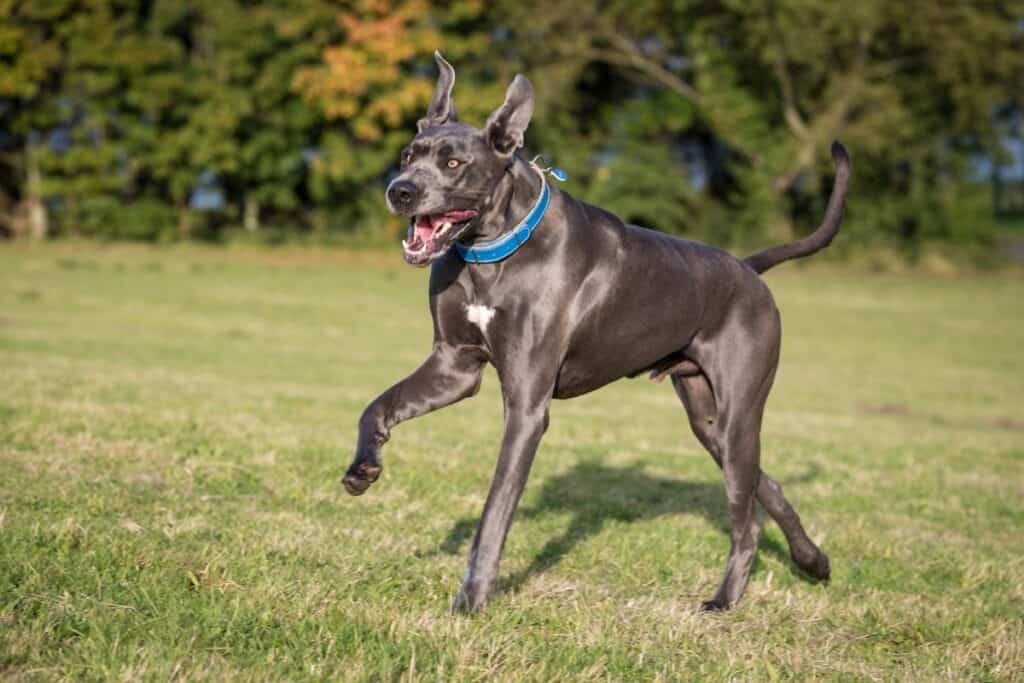
Dog Training and Exercise
Training and exercise are crucial for the health and well-being of Blue Great Danes.
These gentle giants require regular exercise to keep them healthy and happy.
However, as they are a large breed, it is important to start training and exercising them from a young age to effectively manage their size and strength.
Exercise
Great Danes are a working breed and require moderate exercise to keep them healthy. Walking them daily is a great exercise for both the owner and the dog!
However, it is important to note that walking should not be the only form of exercise that they receive. Just like humans, Great Danes can get bored with the same routine each day, so it is important to mix up their exercise routine.
In addition to walking, other forms of exercise that Blue Great Danes may enjoy include swimming, hiking, and playing fetch.
However, avoiding excessive exercise, especially in puppies, is important as it can cause joint problems later in life.
Training
Blue Great Danes are highly intelligent and eager to please, making them easy to train. It is important to start obedience training early in their life to ensure that they are well-behaved and manageable.
Positive reinforcement techniques such as treats, praise, and playtime are highly effective in training Blue Great Danes.
In addition to obedience training, mental stimulation is also important for Blue Great Danes.
Engaging in activities such as puzzle toys, scent training, and agility training can help keep them mentally stimulated and prevent boredom.
Agile
Despite their large size, Blue Great Danes are surprisingly agile. They can jump and run, and many enjoy participating in agility training.
Agility training can help improve their coordination, balance, and overall fitness.
In conclusion, training and exercise are essential for the health and well-being of Blue Great Danes. These gentle giants can live happy and healthy lives with proper training and exercise.
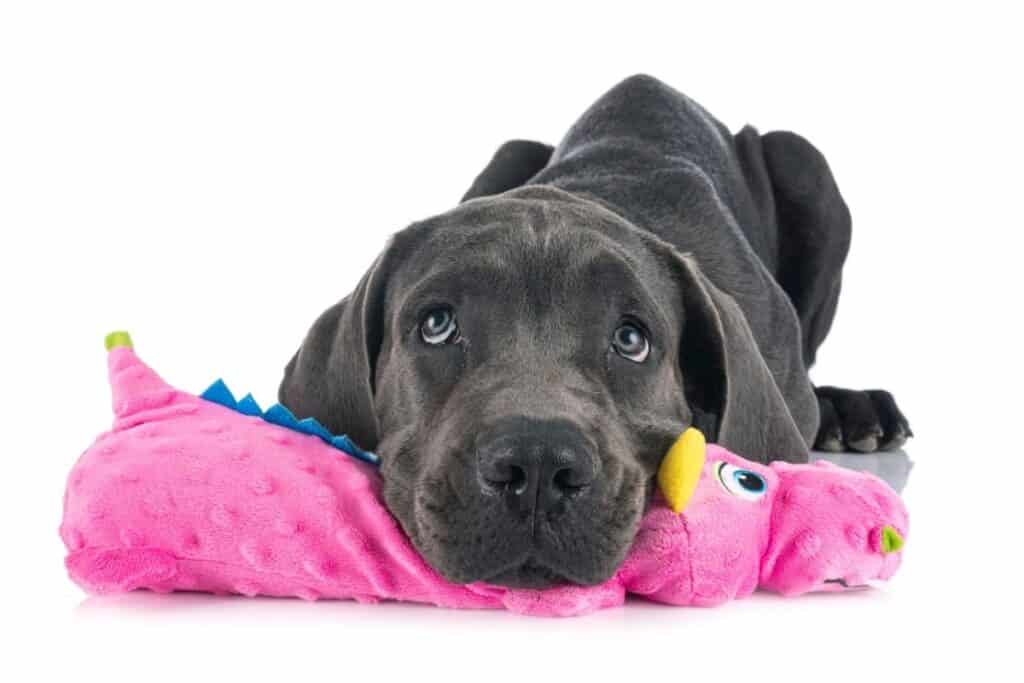
Caring for Blue Danes
Blue Great Danes are majestic and awe-inspiring dogs that require special care.
Here are some essential tips for taking care of your Blue Great Dane:
Grooming
Blue Great Danes have short, sleek coats requiring minimal grooming.
However, regular brushing is necessary to keep their coat shiny and healthy.
- Brushing also helps to remove loose hair and prevent matting.
- It is also important to keep their nails trimmed to prevent them from getting too long and causing discomfort.
- Regular teeth cleaning and ear cleaning are also necessary to maintain good hygiene.
Socialization
Blue Great Danes are gentle giants that love to be around people. They are social animals and require plenty of socialization from an early age. Socialization helps them to develop good behavior and become well-adjusted dogs.
Make sure to introduce your Blue Great Dane to different people, animals, and places to help them become comfortable in new situations.
Positive reinforcement training is also essential to help them learn basic commands and good behavior.
Exercise
Blue Great Danes are large dogs that require plenty of exercise to stay healthy and happy. They need daily walks and playtime to burn off excess energy and maintain their weight.
However, avoiding over-exercising your Blue Great Dane is important, especially when they are young. Over-exercising can cause joint problems and other health issues.
Food
Blue Great Danes require a balanced diet that is rich in nutrients to support their growth and development. Make sure to feed them high-quality dog food that is specifically designed for large breeds.
Avoid feeding them table scraps and human food, as these can cause digestive problems and other health issues. Ensure they have plenty of fresh water to keep them hydrated.
Following these essential tips ensures that your Blue Great Dane stays healthy, happy, and well-adjusted.
Breeding These Dogs
Breeding blue Great Danes requires a breeder to have extensive knowledge of genetics and breeding practices.
The blue color in Great Danes is a result of a recessive gene that dilutes the black color, resulting in various shades of blue, ranging from steel blue to charcoal blue.
When breeding blue Great Danes, it is important to ensure that both parents carry the recessive blue gene.
Breeding two blue Great Danes together increases the chances of producing blue puppies but also increases the risk of genetic health issues.
Breeders must carefully consider the potential risks before breeding two blue Great Danes together.
The breed standard for Great Danes allows for blue coats, but it is important to note that blue Great Danes should not be bred with brindle or harlequin Great Danes.
Breeding blue Great Danes with these colors can result in health issues and deformities in the litter.
When breeding blue Great Danes, it is essential to prioritize the health and well-being of the litter. Breeders should ensure that the litter receives proper nutrition and medical care to reduce the risk of health issues.
In terms of litter size, blue Great Danes typically have litters of 6-8 puppies. However, litter size can vary depending on various factors, such as the age and health of the mother.
Overall, breeding blue Great Danes requires a breeder to have a deep understanding of genetics and breeding practices.
Breeders must prioritize the health and well-being of the litter and carefully consider the risks before breeding two blue Great Danes together.

Adopting a Dane
Adopting a Blue Great Dane can be an exciting decision for any family or individual.
Blue Great Danes are known for their unique appearance, gentle personality, and companionship.
However, before making the decision to adopt a Blue Great Dane, there are a few things to consider.
1. Family and Home
Blue Great Danes are big dogs and require a lot of space to move around. Families with limited living space may want to consider a smaller breed.
Additionally, Blue Great Danes require a lot of attention and socialization to prevent them from becoming bored or destructive.
2. Family Pet and Socialization
If the family already has a pet, it is important to ensure that the Blue Great Dane will get along with them.
Socialization is key in ensuring a Blue Great Dane gets along with other pets and people.
Proper socialization should begin early in the puppy’s life and continue throughout their adulthood.
3. Appearance and Uniqueness
Blue Great Danes are known for their unique appearance, with a steel blue coat and blue eyes.
However, it is important to note that not all Blue Great Danes have blue eyes.
They may have amber, light brown, or dark brown eyes.
4. Personality and Companionship
Blue Great Danes are known for their gentle personality and make great companions. They are loyal and protective of their family, making them great guard dogs.
However, it is important to note that they can be sensitive and require positive reinforcement training to prevent aggression.
5. Purchasing and Intention
When purchasing a Blue Great Dane, it is important to do research on reputable breeders and the Great Dane Club of America (GDCA).
It is also important to have a clear intention to adopt a Blue Great Dane and ensure that the dog fits into the family’s lifestyle.
6. Health
It is important to note that Blue Great Danes, like all Great Danes, can be prone to certain health issues such as hip dysplasia and bloat. Monitoring their health and taking them to regular check-ups with a veterinarian is important.
In conclusion, adopting a Blue Great Dane can be a great decision for the right family or individual. It is important to consider the dog’s unique needs and ensure that they will fit into the family’s lifestyle.
Proper socialization, training, and attention can ensure a happy and healthy life for a Blue Great Dane.
Frequently Asked Questions
ARE BLUE GREAT DANES RARE?
Yes, blue Great Danes are considered rare. They are not as common as black, fawn, or brindle Great Danes. The blue coloration is caused by a recessive gene that can be difficult to breed for.
However, it is important to note that the blue coloration is not a guarantee of rarity, as it can also be found in other breeds.
HOW MUCH DOES A BLUE GREAT DANE COST?
The cost of a blue Great Dane can vary depending on the breeder, location, and other factors. A blue Great Dane can cost anywhere from $1,500 to $5,000 or more.
Researching and finding a reputable breeder who health tests their dogs and properly cares for their puppies is important.
WHAT IS THE RAREST COLOR OF GREAT DANE?
The rarest Great Dane color is merle, which can come in various colors, including blue and fawn.
However, it is important to note that breeding for certain colors or patterns can lead to health issues, and responsible breeders prioritize the health and well-being of their dogs over aesthetics.
WHAT IS THE AVERAGE LIFESPAN OF A BLUE GREAT DANE?
The average lifespan of a blue Great Dane is similar to that of other Great Danes, which is typically 7-10 years.
However, some Great Danes may live longer with proper care and attention to their health needs.
CAN BLUE GREAT DANES HAVE HEALTH PROBLEMS?
Like all Great Danes, blue Great Danes can be prone to certain health issues such as hip dysplasia, bloat, heart issues, and thyroid problems.
Working with a veterinarian and monitoring their health throughout their life is important to ensure they receive proper care and treatment.
WHAT ARE SOME COMMON HEALTH ISSUES FOR GREAT DANES?
Some common health issues for Great Danes include hip dysplasia, bloat, heart issues such as dilated cardiomyopathy, and thyroid problems.
Additionally, due to their large size, they may experience joint and bone-related issues, making it crucial to monitor their growth and weight throughout their lives.
Responsible breeders will health test their dogs and work to minimize the risk of these health issues in their breeding programs.
If you found this article helpful, make sure to take a look at some of my other related articles below!
